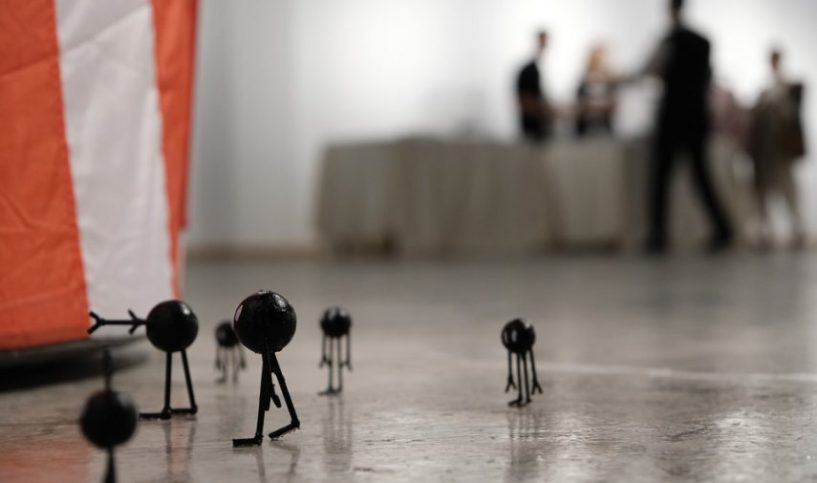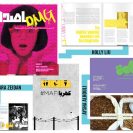By Umjay M.
They’re hard to miss. Lurking in the background, curiously observing. You catch them at meetings, when you’re out for coffee with friends, sometimes even at events around town, popping up in the shadows of the flash of a random group selfie. Peeping at you from behind a stickerbomb of other creatures, all manifestations of someone else’s thoughts, all fighting for a little bit of your attention. Dark and withdrawn enough to ward off unwanted attention, they carry the innocence of an inquisitive child, one that makes it so that you can’t help but give them that little bit of attention that they almost secretly, desperately seek.
Do you ever wonder how many people have had the exact same thoughts as you? It is said that on average, we have between 50 and 70,000 thoughts a day. That comes out to somewhere between 35 and 48 thoughts a minute. That’s a lot to process. And while most are fleeting thoughts of everyday life, underneath those, linger a small group of thoughts, lurking in the background, curiously observing, persistently prodding, demanding to be heard. Accompanying you throughout your days, evolving, adapting, they grow familiar, almost friendly. While most of us spend our lives fighting them, Faisal Babajan thought it better to befriend them, make them his own. After all, they were purely social demons trying desperately to make a connection.
Himself a soft-spoken introvert, it is easy to see Faisal in his demons. They were him, just slightly more social, somewhat darker, and spoke up when Faisal would otherwise have chosen not to – his alter ego, if you will. They were born during Faisal’s childhood as he struggled to make friends while constantly moving schools. Instead of silencing them, he used them as a means to connect with others. Simple, relatable and most importantly, recreatable, Faisal hoped people would recognize themselves in his demons, enough to make them their own. Because, whether or not we have the exact same thoughts, we all have demons.
In his show Heterotopia Demons, Faisal invited a group of fellow artists to participate in what he called the PS.Demons Sketchbook Project. Held in DIA Yarmouk on an April evening, as you make your way through the pristine halls, you know you’ve arrived when you find yourself face-to-face with a 2-foot, 3D demon, greeting you at the door. Demons are everywhere. On the walls, on the floors, suspended midair, strapped to a tree of helium balloons, you forget the soft murmurs of the crowd, completely pass up the opportunity for what looked like an amazing, fresh fruit cocktail, and become fully engaged with these little creatures. As you slowly step out of your head and look up at the faces around you, you begin to connect the dots between artist and demon.
In this project a variety of regional illustrators and artists were given two pages to fill in one week. One was to be filled with their choice of art to express who they are as artists, and on the other, they were to recreate Faisal’s demons using their own style. Not only did it make for a beautiful contrast between the many different interpretations of the demons, but it brought together artists from different genres who otherwise may not have connected.
Among the participating artists was Alaa Ahmed. A classical artist who specializes in portraits, his demon takes on a much less-friendlier demeanor. Perfectly framed in gold, no longer innocent and curious, it takes on the form of a human, disturbingly lifelike, portraying a much darker energy than that of its original counterpart. Zahra Al-Mahdi, infamous for her anatomical cross section mixed-media art, shared with us the internal anatomy of her demons. An unamused Qumooth of the Doghouse Collective stands on a bag of falafel, surrounded by a group of four toddler-like demons. One, upside down in her right hand, legs flailing in the air, the other climbing the side of her face, the third sitting atop her right foot, fiddling, the fourth, standing to the side, looking up at her stare.
While most of the artists dressed up their demons, or integrated them into the backgrounds of their story, one artist in particular chose to interact with hers. Ghadeer Al Mesri is shown addressing her demon – resting on the palm of her hand, it reaches back toward her face. Lurking in the corners of Sheena’s mind, she writes to them, responding to their calls for attention with positive reinforcement, accepting their existence, and understanding their importance.
Thoughts are tricky little things. I mean, they’re not real, they’re just thoughts. But the mind is a powerful tool, and that small group of thoughts that’s been lingering in the back of your mind ever since that one kid in the fifth grade called you awkward, have been evolving and adapting and slowly coming to life. So instead of trying to ignore them, or worse yet, fight them, Faisal invites you to #EmbraceYourDemons.
Participating Artists: Zahra Al-Mahdi; Mohammed Al-Mohanna; Reem Madooh; Thuraya Lynn; Alaa Ahmed; Ghadeer Al-Mesri; Tareq Sultan; Sheena Doesn’t Know; F160; Dochan; Kristina Egle; Nizzy; Norah A-Jassar; Athoub Al-Busaily; Ricardas Blazukas; Dh_c.
Photography by: Salman Moghaddam.
Originally published on www.kingdome.co. You can follow Kingdome on Facebook and Soundcloud @KingdomeMagazine, Instagram @Kingdome.co, Twitter @KingdomeCo and on YouTube: Kingdome Magazine.











